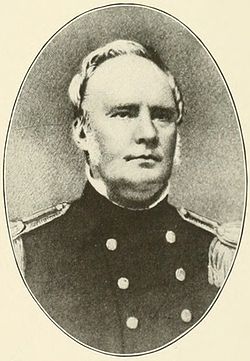After the fall of Vicksburg, the Transmissippi,
Confederate states west of the Mississippi, were cut off from the
rest of the Confederacy. However, campaigns still continued there.
Kirby Smith, Confederate commander of the theater, came up with a
plan for an offensive campaign. He ordered Stirling Price to lead an
army into Missouri, and capture St. Louis or Jefferson City, the
capitol. He was then to move into Kansas and the Indian Territory,
rounding up supplies that would be of use to the south. Price had
12,000 men in three divisions. They were mostly cavalry, but he hoped
that Missourians would flock to join his army.
 |
| Price |
Price began his expedition in September, 1864.
Cavalry set out to pursue him, along with A. J. Smith's corps of
infantry. He skirmished around St. Louis and Jefferson city, but
determined that they were too heavily fortified for his men to
capture. Instead he turned west, and headed for Kansas. Samuel
Curtis, the Federal commander in Kansas, was hurrying to gather
troops to meet him. The Federals were not not prepared to meet this
attack, but Curtis was able to gather 22,000 men into his Army of the
Border, most of whom were militia. By this time Price's forces
numbered less than 9,000, depleted by the marching and fighting.
As Price advanced toward Westport, Missouri,
modern day Kansas City, he knew he was in trouble. Curtis was making
a stand at Westport, but Price was also being pursued by Union
cavalry under Alfred Pleasonton. He would try to deal with the Union
armies one at a time, first attacking Curtis at Westport. The battle
was fought on October 23rd, 150 years ago today.
 |
| Fighting at Brush Creek |
The fighting began when Union skirmishers
advanced across Brush Creek. The Confederate divisions of Joe Shelby
and James Fagan attacked, and drove back the Federal brigades. Curtis
arrived on the field, and sent reinforcements in to counterattack.
They were driven back, so he looked for another way to strike Price's
army. A local farmer named George Thoman pointed the Union troops to
a gulch which led to Shelby's left flank. Curtis sent his escort and
the 9th Wisconsin Battery to move up this ravine to the
Confederate flank. This gave the Yankees the edge they needed, and
they began to make progress in their attacks, slowly pushing the
Confederates back.
 |
| Byram's Ford. Source. |
Price's rear was also in danger. Pleasonton's
pursuing Union cavalry drove the Confederate rearguard away from
Byram's Ford. The Confederates soon realized their danger, and Price
ordered a retreat to escape from the encircling Federal forces.
Disengaging from Curtis' forces was difficult, and at several points
Confederate brigades in the rear were broken. The retreat was hasty,
and many rebels threw away gear which they could no longer carry. To
cover the retreat, the Confederates set the prairie on fire, so they
would be shielded by a smoke screen.
 |
| Confederate cemetery. Source. |
Price headed south, with the Union forces still
in pursuit. He was able to reach Confederate territory after several
skirmishes, but with about half the men he had set out with. The
Battle of Westport was one of the most important in the
Transmississippi Theater. It has been called the Gettysburg of the
West, because it cemented Union control of Missouri and generally
ended further Confederate campaigning.



